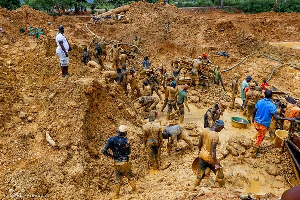Embarking on a construction project in Ghana can be an exciting endeavor, brimming with opportunities to create one’s dream property or investment for the future. However, the journey from the vision to reality commences with compliance with an imperative list of well-established and regulated frameworks.
Ghana's regulatory regimes including compliance with zoning regulations, environmental factors, and building permits among others, provide standards for the commencement of any construction activity. Every phase of a construction undertaking demands meticulous planning, a keen understanding of local laws, and unwavering attention to detail to safeguard the project's viability.
The fact of land acquisition is only in support of evidence of ownership of land and not a permit to commence construction activity without compliance with regulations in force at a particular time.
This article therefore intends to provide a checklist to measure compliance with laws and ensure construction projects do not only come to fruition but do so in strict adherence to best practices and regulatory demands in Ghana.
REGULATORY LANDSCAPE FOR CONSTRUCTION IN GHANA
In the ever-changing construction sector where towering structures reach for the sky and fascinating infrastructure shapes our cities, there is an unseen force at work: “Regulation”. Like an invisible hand guiding the process, construction activities are enabled by a web of rules and standards to ensure the safety, sustainability, and quality of construction works.
From skyscrapers to humble homes, the construction industry operates under a watchful eye of regulation, driven by the imperative to protect lives, preserve the environment, and simply beautify and promote the orderly development of our communities. And understanding the legal framework is essential for both developers and individuals looking to build.
Regulating the construction industry involves adherence to various standards and regulations and in Ghana, several key regulatory bodies oversee this sector including the Town and Country Planning Department (TCPD), Ghana Standards Authority (GSA), the Environmental Protection Agency (EPA), Metropolitan, Municipal, and District Assemblies (MMDAs), National Building Regulations, Building and Road Research Institute (BRRI).
By effectively coordinating and enforcing these regulations, these regulatory bodies contribute ultimately to a robust and thriving construction industry.
THINGS TO DO BEFORE BREAKING GROUND: BUILDING CONSTRUCTION CHECKLIST
There are several important tasks and considerations to address before breaking ground to commence a building project. Here are the top ten (10) key ones:
1) CONDUCT A THOROUGH SITE ASSESSMENT: A comprehensive site assessment includes evaluating the site's geological conditions, topography, soil quality, and any potential environmental impacts. This assessment will help you determine if any site preparation or mitigation measures are necessary.
2) ENGAGE WITH LOCAL COMMUNITIES AND STAKEHOLDERS: For individuals primarily interested in utilizing the property for investment purposes, it is advisable to prioritize the establishment of constructive connections with local communities and stakeholders. This can be achieved by actively engaging in consultations and discussions to understand their concerns, proactively address potential issues, and ensure that the project aligns with their needs and expectations.
3) STRUCTURAL DRAWINGS: Structural drawings should be done in the pre-construction phase as they are crucial for ensuring the safety, compliance, and coordination of a building project. These drawings encompass detailed plans and specifications that outline the design and placement of load-bearing elements, such as beams, columns, walls, and foundations. They also incorporate calculations for structural integrity, including factors like live loads, dead loads, wind loads, seismic requirements, and fire protection measures. By following these drawings, construction professionals can ensure the structural stability of the building complies with local building codes, coordinate the integration of different components, plan construction activities and estimate costs accurately, and facilitate effective communication among project stakeholders.
4) ARCHITECTURAL DRAWINGS: Architectural drawings are visual representations that communicate the design intent and technical details of a building or structure. They include plans, elevations, sections, and details, created using computer-aided design software. These drawings facilitate communication among stakeholders, aid in obtaining permits, guide construction, and serve as a valuable record for future reference. Architectural drawings combine technical precision and artistic representation to ensure a shared understanding of the design, assist in the construction process, and document the building's historical and architectural significance.
5) BUILDING PERMIT: There is a common misconception that acquiring a building permit grants you the unrestricted right to put up any structure on your land. In essence, the belief is that obtaining a building permit is all that is required for construction. This prevalent misconception needs to be addressed. In Ghana, a building permit is a vital component of the construction process, serving as official authorization from the appropriate regulatory body to commence building activities. The essence of a building permit lies in its role as a safeguard, ensuring that construction projects meet prescribed standards and adhere to relevant regulations.
The issuance of a building permit signifies that the proposed construction plans have been thoroughly reviewed and evaluated by the responsible authority. This evaluation takes into account factors such as structural integrity, compliance with building codes, adherence to zoning regulations, and consideration of environmental impact. By obtaining a building permit, builders and property owners demonstrate their commitment to responsible construction practices and their willingness to comply with legal requirements.
Once a building permit is obtained, it does not grant complete freedom to proceed with construction without further involvement from the District Planning Authority. The permit holder must regularly notify the Authority of the intention to commence work and provide regular updates on the various stages of construction. Each stage, such as foundation work or roofing, must be inspected and approved by the Authority before proceeding to the next.
6) FIRE REPORT: A Fire Report is essential before construction to ensure compliance with fire safety regulations, protect life and property, and prioritize worker safety. The report assesses and addresses fire safety compliance, including the installation of fire protection systems and emergency exits, and evaluates risks to the construction site and neighboring properties. By incorporating fire safety measures early on, the Fire Report helps create a safe and secure environment for occupants, workers, and nearby structures, reducing the potential for injuries, fatalities, and property damage due to fires.
7) ENVIRONMENTAL PERMIT: This permit evaluates potential environmental impacts, such as pollution and waste management, and ensures compliance with environmental regulations. By obtaining an Environmental Permit, construction projects can minimize harm to the environment, comply with laws, engage stakeholders, promote sustainability, and maintain environmental quality throughout the construction process.
8) HIRE QUALIFIED PROJECT TEAM: Assemble a team of professionals, including architects, engineers, contractors, and consultants, who are experienced in the construction industry. These professionals bring their specialized skills and experience to the table, contributing to the effective execution of the project. Their collective knowledge enables seamless coordination, efficient problem-solving, and adherence to local regulations and building codes. By investing in a skilled project team, investors can maximize project outcomes, minimize risks, and achieve timely and high-quality construction results.
9) ENSURE YOUR PROJECT TEAM ADHERE TO HEALTH AND SAFETY MEASURES: It is crucial to prioritize the health and safety of both workers and the surrounding community when undertaking any construction project. Often, the importance of this requirement is overlooked, but it is essential to consider that the risks have future consequences. An employer or main contractor can be held responsible for the actions or negligence of their employees or subcontractors. This liability arises when the actions occur within the scope of their employment or while carrying out work on behalf of the employer. To mitigate vicarious liability risks, it is essential to recruit a competent workforce, provide them with appropriate work tools and adequate supervision and training.
Picture a scenario where workers are seen working without proper safety gear, such as helmets. This will not only put their personal well-being at risk but also jeopardize the overall safety of the construction site. Without adequate head protection, workers are vulnerable to serious head injuries in the event of accidents or falling objects.
Workers must be made aware of the importance of taking health and safety precautions seriously to mitigate potential risks and ensure a safe working environment.
10) IMPLEMENT SUSTAINABLE INITIATIVES: Currently, the conversation of going green has shifted to green construction. In response to the environmental concerns surrounding construction materials, there is a growing emphasis on sustainable initiatives within the industry. It has been observed that construction materials significantly contribute to environmental degradation. As a result, there is a call for construction companies to adopt green practices and implement sustainable initiatives in their operations. For example, construction companies can incorporate green building practices by using environmentally friendly materials such as recycled or low-impact materials in their projects.
They can also prioritize energy efficiency by installing energy-saving systems, such as solar panels or efficient insulation. Implementing water conservation measures, such as rainwater harvesting systems or low-flow plumbing fixtures, can also contribute to sustainability. Additionally, construction companies can adopt waste management strategies, such as recycling and proper disposal of construction debris, to minimize their environmental footprint. By implementing these and other sustainable initiatives, construction companies can help mitigate the environmental impact of their activities and contribute to a more sustainable and eco-friendly construction industry.
CONCLUSION
Before one begins a construction activity in Ghana, a prelude to breaking ground involves understanding the various best practices and regulatory undertakings. It is an epic journey that demands an understanding of the laws, regulations, best practices, and permits that wield their mighty influence over every facet of construction. Those who desire to embark on this odyssey must cross treacherous legal waters, lest they provoke the penalties and disputes that lie in wait.
Embracing the wisdom of qualified professionals, erecting fortresses of safety, and championing sustainable initiatives, can rise above the challenges and shape a celestial landscape where construction thrives, leaving an indelible mark upon the realm of construction in Ghana. And the recommended checklist items in this article are a must.
General News of Monday, 11 December 2023
Source: Adwo Birago Nyantakyi













